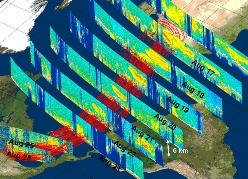 | The Imaging Infrared Radiometer (IIR) for PICASSO-CENA is an infrared three channel
broadband radiometer which is based on the use of an infrared microbolometer camera.
The basic function of the IIR is to provide Earth images in three spectral bands at a period of time
of 8s.
The radiometric requirements are such that complementary functions need to be implemented in the
instrument :
- an in-flight calibration is required to cope with environmental and ageing instabilities,
- three spectral bands have to be analysed in the overall spectral range 8.5 – 12.4 μm. The IIR is composed of (figures 2 and 3) :
- an Imaging Sensor Module (ISM), derived from the camera developed for IASI. The optics is
completely redesigned because of the very different constraints. Radiator and sun shield are also
modified to adjust the design to the IIR specific thermal interfaces,
- a rotating filter wheel holding 3 filters placed in front of the ISM,
- a black body for in-flight calibration,
- a folding mirror mounted on a mechanism to allow Earth, black body and deep space sighting,
- an electronic control box which supplies, commands and controls the IIR sub-assemblies and
interfaces with the payload,
- a mechanical structure that support all above sub-assemblies and is fixed to the payload. AGENCY: CNES |

